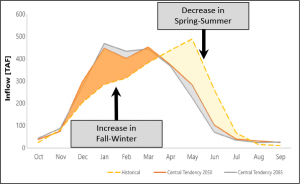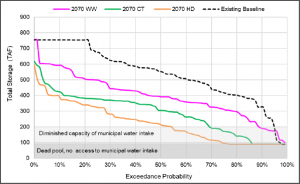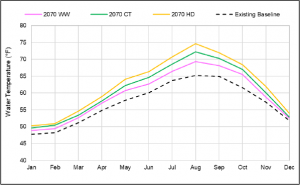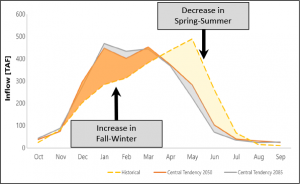The U.S. Bureau of Reclamation has released a long-awaited study that identifies future climate and hydrology projections and outlines gaps between water supplies and projected urban and agricultural demands in the American River Basin.
The study, which was developed in partnership with local water providers, including the Regional Water Authority, describes regional vulnerabilities and strategies for adaptation designed to address climate vulnerabilities in the American River watershed, which stretches from Sacramento to the foothills.
“The American River Basin Study is one of the most sophisticated evaluations of climate change impacts on water supplies in California to date, using the best available science and latest modeling tools to forecast potential impacts on water supply, water quality, and critical habitat within the Basin,” said Andy Fecko, General Manager of the Placer County Water Agency, which served as lead local agency. “This level of analysis is needed to fully understand the impacts of climate change and encourage a coordinated effort to address the unique vulnerabilities of our region.”
Key climate challenges impacting water supply, water quality, and critical habitat within the American River Basin:
Significant increases in temperature of 4 to 7 degrees (F) by the year 2085. The most remarkable change is seen in the upper watershed, which will significantly impact snowpack, our largest storage reservoir. Precipitation will fall more as rain and less as snow, resulting in runoff peaking 35 days earlier by the end of the century—in February through March rather than in May—with significant impacts on the current water management system and environment of the American River, including:

Projected impacts to runoff
- Reduced snowpack in the upper watershed, directly impacting water supply reliability, power generation, forest health, and recreation for communities above Folsom Reservoir from summer through fall.
- Increased flood risk in the winter, prompting more flood releases from Folsom Reservoir, and decreased runoff in spring. This will reduce water available in Folsom during summer and fall for drinking water, hydropower, irrigation and recreation, making the region more vulnerable to shortages.
- Increased risks for wildfires from drier soils resulting from increased temperatures and decreased snowpack in the upper watershed.
- Decreased flows and increased temperatures in the Lower American River in summer and fall, threatening native Chinook salmon during future fall spawning.
The need for water, even with conservation measures in place, will grow by 7 percent to 8 percent due to more prolonged and hotter summers.

Projected impacts to reservoir storage
The study partners evaluated potential strategies to address climate challenges, improve water supply reliability, and enhance Reclamation’s flexibility in operating Folsom Reservoir to meet flow and water quality standards in the Delta and ensure environmental protection. Each strategy addresses different sets of climate impacts in the watershed because no one adaptation portfolio can address all of the identified vulnerabilities.
“The adaptation strategies outlined in the Basin Study are consistent with state and federal plans and initiatives for adapting to climate change,” Fecko said, noting Governor Newsom’s plan, “California’s Water Supply Strategy: Adapting to a Hotter, Drier Future.” “The Basin Study outlines an array of solutions that can be implemented at the local level and create mutual benefits for Reclamation and statewide water managers.”
Regional climate adaptation strategies Include:
- The Sacramento Regional Water Bank—an innovative groundwater storage program utilizing the reservoir under our feet that can hold enough water to fill Folsom Reservoir twice. The Water Bank is expected to offset the loss of snowpack. The Water Bank will provide more opportunities to capture and store excess water

Projected impacts to water temperatures in the Lower American River Basin
when it’s available during wet times so that it is available during dry times for water supplies and the environment of the Lower American River. any water agencies have or plan to construct groundwater wells equipped with technology to bank flood or excess surface water below the ground.
- RiverArc—a transformative water reliability project, using an existing diversion point, which offsets demands on the American River and Folsom Reservoir by integrating surplus water off the Sacramento River to homes and businesses in Placer and Sacramento counties. This new system will integrate groundwater and surface water supplies – used conjunctively – for agencies to share across the region.
- Alder Creek Reservoir and Conservation Project—a high-elevation, off-stream storage project that would increase the total Upper American River watershed storage to 2 million acre-feet. Alder Creek would replace lost storage from reduced snowpack and capture earlier snowmelt to improve water supply reliability in the Foothills and CVP water supply from Folsom Reservoir.
- Folsom Dam Raise with Groundwater Banking—a multi-benefit project leveraging the authorized Folsom Dam raise for forecast-informed reservoir operation that integrates the operation of upstream storage facilities to provide 500-level of flood protection for the Sacramento region and additional water supply benefits for Reclamation at Folsom Reservoir and potential groundwater recharge along the Folsom South Canal.
- Modified Flow Management Standard (MFMS)—a flow standard, refined over the past two decades, to protect, restore, and maintain sufficient temperatures for salmon and steelhead while improving the reliability of water supplies for people. The MFMS uses the best available science to set minimum river flows and targets for the amount of water to be stored at Folsom Reservoir – balancing the co-equal objectives of providing a reliable and safe water supply while preserving the environment of the Lower American River.
In addition, the Basin Study identified climate change’s projected impact on forest health and wildfire as a potentially catastrophic vulnerability to the American River region’s natural and built water supply infrastructure. “While not identified as an adaption strategy, we know that active forest management is important to clean and reliable water supplies,” Fecko said.
Regional water managers are currently evaluating and pursuing these strategies to maintain the region’s economy, environment, and quality of life.
Reclamation partnered with local water providers to develop this basin study, including Placer County Water Agency, El Dorado Water Agency, City of Folsom, City of Roseville, City of Sacramento and Regional Water Authority, in coordination with the Sacramento Area Flood Control Agency. In addition, key contributors included the California Department of Water Resources, University of California—Davis, the Water Forum, Sacramento Municipal Utility District and El Dorado Irrigation District.
The American River Basin Study is part of Reclamation’s WaterSMART Program. The full report is available at https://www.usbr.gov/watersmart/bsp/arbs/.


